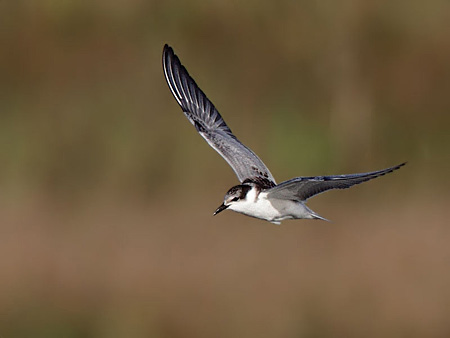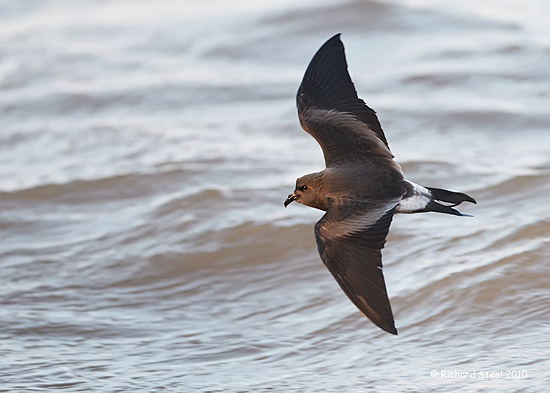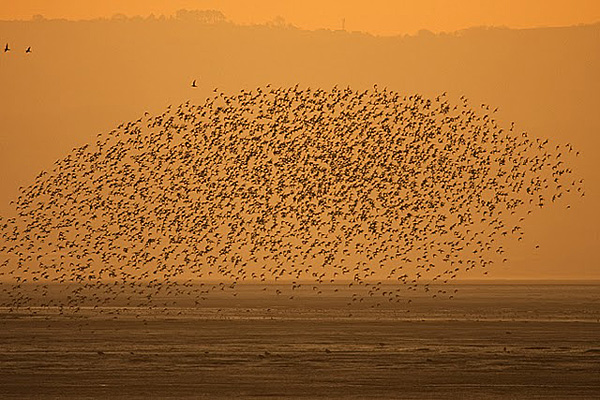Site menu:

March 2011 Newsletter
Highlights - March 2010 to February 2011.
Voluntary Wardens Wanted for Neston Reedbed.
February Bird News.
Forthcoming Events.
Latest Newsletter.
Highlights - March 2010 to February 2011

This website is 13 years old this month and as usual I do the highlights for the past 12 months.
It has to be the best 12 months since the website began - just fantastic! There were many cracking rarities - I list 24 below, a good spring migration, September gales, one of the coldest winters for many years, several species recorded record high numbers and there was one of the best Waxwing winter's in living memory.
Rarities
Seabirds: Two rare gulls turned up at Leasowe in April, an Iceland Gull and Glaucous Gull, followed by two Velvet Scoters off Hilbre. The return migration brought a Roseate Tern to New Brighton on July 17th. September gales resulted in some fabulous birding including a Little Shearwater, no doubt one of the birds of the year and one I was lucky enough to see. Single Sooty Shearwaters were seen on two days, there were two Long-tailed Skuas on the 14th and singles the following two days. Sabine's gulls were recorded on four days with at least three on the 15th and 16th and four on the 17th. The next two 'sea bird' records, in as much as they were on the sea, were two Slavonian Grebes off Red Rocks on September 28th and a Red-necked Grebe off Hilbre on January 8th. One to two Velvet Scoters were reported on several dates in January and into February. The year ended, as it began, with two gull records. A Glaucous Gull flew past Hilbre on February 6th, but an American Herring Gull on February 19th at Hoylake meant the past 12 months ended on a really high note.
The Rest: Rare waders included a Lesser Yellowlegs at Inner Marsh Farm in the first two weeks of August followed by a Long-billed Dowitcher there at the end of the month which was also seen at Connah's Quay. It was seen again a month later at the latter site. A Stone Curlew was on Hilbre on September 6th and a Buff-breasted Sandpiper at West Kirby briefly on September 19th. September continued to be an exceptional month with a Whiskered Tern spending time at both Inner Marsh Farm and Burton Marsh followed a few weeks later by a White-winged Black Tern. That leaves a Bluethroat (Leasowe) and Nightingale (Hilbre) in May, a Barred Warbler passed through Hoylake in early September and two Shorelarks in early January on Hilbre.
Record High Numbers, Irruptions and Passages
An early start to the winter in Iceland, coupled with the very cold weather here in the UK and Scandinavia in November and December, no doubt contributed to the high numbers of some species. With others it was due to September gales. But whatever the reason it has certainly been a remarkable 12 months.
The year started with a good spring migration, of particular note were Yellow Wagtails and Ring Ouzels. There were a total of 23 reports of Yellow Wagtails in April and May including counts of 12 at Leasowe Lighthouse and 10 at Inner Marsh Farm. There were many reports of Ring Ouzels with two staying for a week around Leasowe Lighthouse and two counts of three there during April.

It was a fairly quiet summer for sea watching but by mid-August Manx Shearwater numbers picked up and the count of 750 observed from Hilbre on the 20th was one of the highest ever there. The following day an amazing 31 Goosanders landed on rocks on Hilbre, although an occasional flock of up to 40 have been recorded over the years flying by - this is the first time anything like this number have been recorded on Hilbre itself. Sea watching really picked up in September with one of the best Leach's Petrel passages for past 40 years or so, including the second highest daily count (524 from Hilbre) since 1978 - Click here for more details. During the gales, as well as the rarities described above, we also had very good numbers of skuas with max daily counts of 45 Arctic Skuas and 15 Great Skuas .
The autumn of 2010 saw what was probably the largest influx of Lapland Buntings ever recorded into this country. We had our share here during late September and into October and November - for details Click here. Next up was what was probably the largest Waxwing irruption into the country ever recorded! The first one turned up here on October 24th when one was seen flying inland from West Kirby. By November they were recorded around the Dee Estuary almost on a daily basis with max 20 at Holywell on the Welsh side and 30 at Neston on the English side, and much larger numbers further inland (e.g. at least 100 at Denbigh, Northwich and Ruthin). The next influx was of Bramblings, our first arrived at both Hilbre and Thurstaston on Oct 10th, by November they were widespread with many coming to garden feeders - max was a flock of 200 over West Kirby in December.
Then came the cold winter, we didn't get a great deal of snow here but what we did get lay on the ground for weeks. But it was the cold which was exceptional with nearby Crosby weather station recording -17C on two occasions. West Kirby Marine Lake completely froze over twice, the second time for over a week, but in between times Red-breasted Mergansers reached 52 - the highest ever recorded in the Cheshire and Wirral bird reports for this site. Four figure counts of Skylarks are unusual these days but there were at least 3,000 on outer Burton Marsh on Dec 19th, probably the largest flock since 5,000 were on the marshes in 1997.
We've been seeing large numbers of Great Crested Grebes off north Wirral for a number of years, but the 1,195 counted in perfect conditions on January 20th almost doubled the previous highest record for Wirral, and will be one of the highest counts in the country for this winter. Counts of Pink-footed Geese on the marshes, and feeding on Shotwick fields, have been increasing in recent years, but the 2,000 seen off Parkgate during the spring tides in February is the highest since at least the early 20th century. Pale-bellied Brent Goose is another goose species which has been increasing in recent years and a new maximum was reached when 212 were counted just off West Kirby marsh on January 23rd. Last, but not least, are the wild swans. No doubt due to recent mild winters Bewick's Swans have been steadily decreasing on the Dee Estuary as they stayed further east, they reached a maximum of 110 in 1997. But this winter saw a new maximum of at least 130. In contrast, Whooper Swans have been increasing here in recent years and they increased again to a new high record with also at least 130 present.
Twelve months of exceptional birding!!
Richard Smith

Voluntary Wardens Needed to Protect Neston Reed Bed
 Once again the
RSPB are organising voluntary wardening at Neston Reed Bed, the scheme will
begin near the end of March and run through until the end of May. Wardening will take
place each evening in order to protect this important habitat from
disturbance. I know in the past this scheme has
attracted birders who have realised what a good opportunity this location is
for some serious birdwatching with the possibility of seeing migrating
Ospreys and Marsh Harriers, large numbers of Little Egrets flying in to
roost, Bearded Tits, Hen Harriers, Short-eared Owls and the numerous birds
which breed in the reed bed. If you are interested please contact Geoff Robinson (Geoffrey.Robinson@rspb.org.uk),
telephone 0151 336 7681.
Once again the
RSPB are organising voluntary wardening at Neston Reed Bed, the scheme will
begin near the end of March and run through until the end of May. Wardening will take
place each evening in order to protect this important habitat from
disturbance. I know in the past this scheme has
attracted birders who have realised what a good opportunity this location is
for some serious birdwatching with the possibility of seeing migrating
Ospreys and Marsh Harriers, large numbers of Little Egrets flying in to
roost, Bearded Tits, Hen Harriers, Short-eared Owls and the numerous birds
which breed in the reed bed. If you are interested please contact Geoff Robinson (Geoffrey.Robinson@rspb.org.uk),
telephone 0151 336 7681.
February Bird News
The large numbers of gulls present off North Wirral in January continued through February, and yielded a mega-rarity in the form of an American Herring Gull. Also found were six Yellow-legged Gulls, five Mediterranean Gulls and a Glaucous Gull. What the total number of gulls was is difficult to say but between West Hoyle Bank and New Brighton it must have reached at least 15,000 at times.

Despite the wind direction not being ideal the tide did come right up to Parkgate on each of the three high spring tides. We had some great birdwatching including a good selection of raptors, but where did those Short-eared Owls come from? Hardly a single record of them all winter then suddenly 12 are flushed from the marsh. A look at the second graph in my Short-eared Owl article suggests that we do tend to get a late winter influx of this species, although it is quite possible that they have been there all winter but just not shown themselves during the day. The 2,000 Pink-footed Geese observed here on the 19th was probably the highest number recorded on the Dee Estuary since the early 20th century (larger numbers are sometimes seen flying over between Norfolk and Lancashire but not actually over-wintering on the marshes).

© Matt Thomas, see 'From the Muddy Banks of the Dee' Blog.
The max number of Scaup seen this month was 61 and Great Crested Grebes reached 389, both off Leasowe Lighthouse. In a horse paddock at Leasowe Lighthouse was seen a somewhat more controversial bird. I put it down as a possible immature Little Bittern as that seemed to fit the description, but unfortunately the bird was never relocated. It was well seen by one birder (not by a local dog walking non-birder which some people seem to think) who is a regular at the site, he didn't know what it was and asked for help - unfortunately by the time help arrived the bird had disappeared. But whatever it was appeared shortly after prolonged and strong southerly winds - so who knows what that may have blown up here. Another strange bird this month was a Little Stint on the pontoon at New Brighton Marine Lake - an unusual location and time of year for this species. It was identified separately by three different birders on three different days. I have been in contact with one of them, who I know well, and he was very confident of the ID; somebody has suggested it was just a Dunlin, but as well over 20 use that roost every high tide it seems strange if one of them had been picked out wrongly as a Little Stint. 21 Purple Sandpipers (Feb 23rd) and 265 Turnstones (Feb 9th) on the same pontoon must be a good proportion of the total north Wirral/Hilbre flocks for both species - a Greenshank here on the 8th was more unexpected.

The strong gale on the 7th blew in a Fulmar, a rare bird here in winter. A Green-winged Teal was at Inner Marsh Farm on the 9th and 40 Twite on outer Burton Marsh on the 22nd. Two Whimbrel, one heard calling, flew in to the flooded field at Pasture Road, Moreton, on Feb 23rd. Good numbers of Brent Geese were still present at the end of the month with 183 counted from Hilbre.
Please send any bird news to
![]()
Richard Smith.
What to expect in March
I always look forward to the first Wheatear of the year as the first real sign of spring - they are lovely birds to see and once the first one comes through plenty more follow. The table below shows the first arrival date for several of the commoner migrants. Although Cuckoo can no longer be classed as common I've left them in as they are so associated with the arrival of spring. Please let me know if you see an early migrant and I'll put it in the table for 2011.
| Species | 2010 | Location (2010) | 2009 | 2008 |
|---|---|---|---|---|
| Wheatear | 10th March | Leasowe Gunsite | 14th March | 13th March |
| White Wagtail | 12th March | West Kirby | 4th March | 9th March |
| Sand Martin | 18th March | Inner Marsh Farm and New Brighton | 15th March | 16th March |
| Swallow | 18th March | Hoylake and New Brighton | 16th March | 15th March |
| Willow Warbler | 19th March | Thurstaston | 31st March | 31st March |
| House Martin | 30th March | Inner Marsh Farm | 30th March | 11th April |
| Whitethroat | 7th April | Heswall | 11th April | 11th April |
| Swift | 19th April | Heswall | 8th April | 22nd April |
| Cuckoo | 10th May | Red Rocks | 26th April | 23rd April |
Other spring migrants should include our first Sandwich Terns and hopefully a Ring Ouzel or two. The first Osprey may well fly over and Little Gulls will be passing by Hilbre on their way to the Baltic to breed. A few Avocets will be on their way to their breeding grounds in Lancashire - they can turn up almost anywhere - and hopefully some will stay to breed at Inner Marsh Farm RSPB.
But winter is not yet over as far as the birds are concerned. The big tides due on the 20th to 22nd should result in our seeing overwintering Short-eared Owls, Hen Harriers, waders and wildfowl; although probably in smaller numbers than in February. Purple Sandpipers will still be present in good numbers, both on Hilbre and New Brighton, and there will still be a hundred or more Brent Geese around Hilbre early in the month. Sometimes in late winter we can get hundreds of Common Scoter off Point of Ayr and north Wirral, with maybe a Velvet Scoter or two, making for a spectacular sight.
Forthcoming Events
March Highest Spring Tides (Liverpool)
Also see
Tides page.
20th March, 11.18hrs (GMT), 10.1m.
21st March, 12.00hrs (GMT), 10.2m.
22nd March, 12.44hrs (GMT), 10.1m.
Forthcoming Events
Organised by the
Wirral Ranger Service ,
Flintshire Countryside Service and/or the RSPB:
All these events and walks have bird interest, even those not advertised
specifically for birdwatching. No need to book for these events unless
specified - please check below.
Also see 2011 Events Diary.
Saturday 5th March 9:30 am until 12 noon. Birdwatch at
King’s Gap Hoylake.
Join the Dee Estuary Voluntary Wardens, Rangers and staff from the RSPB to watch the birds as they roost
and feed on the incoming tide. Warm clothing and suitable footwear are
essential. No need to book.
Sunday 13th March, - 4pm start, Parkgate RSPB Raptor Watch.
The Dee Estuary Nature Reserve is a vital wintering grounds for many birds
of prey – Discover these impressive birds in their wild habitat, hunting
and roosting on the saltmarsh. Warm clothing and binoculars are
recommended. Call 0151 336 7681 for further details.
Sunday 20th March, 9.30am start. RSPB Parkgate High Tide Birdwatch.
High Tide 11.18am, 10.1m.
Join RSPB wardens to watch the tide rise and hopefully cover the entire saltmarsh at Parkgate. Keep an eye out for the reserve's usual suspects,
such as Short-eared Owls, Hen Harriers, Peregrines and Merlins, as well as hopefully
seeing some of the more secretive species of birds and mammals as they are
forced out by the rising tide. Meet at Old Baths Car Park, Parkgate.
Ring
0151 336 7681 for further info.
Monday 21st March, 10.30am start. RSPB Parkgate High Tide Birdwatch.
High Tide 12noon, 10.2m.
Details as above.
Tuesday 22nd March, 11am start. RSPB Parkgate High Tide Birdwatch.
High Tide 12.54pm, 10.1m.
Details as above.
Saturday 26th March 8:30 am until 2:00 pm. Low tide Birdwatch on Hilbre. Join the Rangers and staff from the RSPB for a low tide visit to Hilbre Island. We should encounter a good variety of waders as they feed on the outgoing tide. Warm clothing and suitable footwear are essential. Sorry no dogs. Please book early as there are limited places available. For booking and further enquiries call: 0151 648 4371.
Sunday 27th March, 1pm to 4pm, An early Spring walk around Royden Park and
Thurstaston Common and discover the wildlife at this time of year.
Strong footwear and suitable clothing advised. No need to book. Sorry no
dogs.
Meet at the Ranger Office, Royden Park (CH48 1NP).
Telephone 0151 677 7594 for further information.
|
 |
The blank (UK) Birding Webring is a collection of quality birding web sites that are based in the United Kingdom. Visit the webring homepage for more information, or A complete list of all the sites in the webring is available by clicking here. previous site in ring : random site in ring : next site in ring |